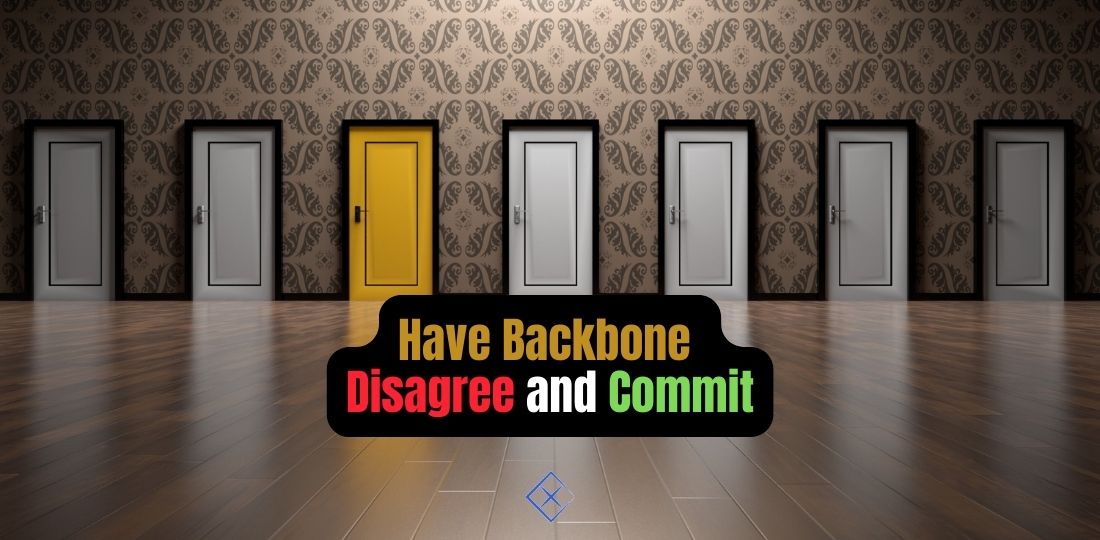Have backbone - disagree and commit
Amazon lives and breathes its 16th leadership principles. All the interviews and performance reviews, the company bases on them. Amazon uses leadership principles every day - in discussing new project ideas, in finding approaches to solving problems, and so on.
Leadership Principles are guidelines of culture and values. Every organization has some equivalent of these.
Amazon, though, takes them seriously and embeds these values and culture into everything that they do. This commitment to the leadership principles helps the organization and employees re-evaluate cultural fitment and behaviors aligned with the culture of the company.
The “16th leadership principles” are the main thing that makes Amazon unique. Leadership principles lead to problem-solving, productivity, and quality decision-making.
In this article, we’ll focus on the 13th leadership principle. The 13th leadership principle of Amazon is: “Have Backbone - Disagree and Commit”.

See also:
https://www.interviewhelp.io/blog/posts/amazon-system-design-interview-questions/
https://www.interviewhelp.io/blog/common-amazon-interview-questions/ (here you can find 16th leadership principle questions).
We’ve covered:
- How does Amazon explain this leadership principle and what does it mean?
- Main ideas introduced by the principle
- Interview questions related to the principle “Have Backbone - Disagree and Commit”.
1. How does Amazon explain the “Have Backbone - Disagree and Commit” leadership principle? What does it mean?
According to Amazon, when leaders receive quality advice contrary to their perspective, they are obliged to respectfully challenge decisions to their team members.
When team members respectfully disagree with them while putting an alternative idea, they don’t feel their authority is being undermined.
Leaders have conviction and are tenacious with their plans. Once a decision is taken collectively, they commit wholly to it, and they do not settle for less for the sake of social solidity.
1.1 What does “Have backbone” mean?
The phrase “to have a backbone” means to have the strength (particularly in the face of adversity). If you “have a backbone,” it means you will stand up for your ideas. Do you fight for your ideas or do you give up on them if someone challenges you?
What if you fight for your idea? Do you disagree with someone, and your idea does not win? Do you try to work against them because your idea didn’t win? Or you’re supporting the person who won?
Amazon works on the following principle: you commit to their idea if it wins, even if their idea was against yours before!
2. Main ideas introduced by the principle: “Have Backbone- Disagree and Commit”
- Showing Responsibility: ( You own the final decision and you are responsible, even if the final decision is not what you wanted).
- Showing Respect: (Show respect for your ideas first, and then wholly respect the chosen decision).
- Demonstrate a skill to compromise without passive aggression (You can’t later say: “ I told you so”, or any phrase that shows passive aggression. You must have the skill for compromising without passive aggression).
3. Interview questions related to the principle: “Have Backbone - Disagree and Commit”
To check your decision-making power and your firm commitment to the relevant job, Amazon will test you on this leadership principle using some questions. Below I’ll list some examples:
- What did you do when other members of your team didn’t agree with your ideas? Describe a situation.
- Tell me about a situation where you had a conflict with someone on your team. What was it about? What did you do? How did they react? What was the outcome?
- Tell me about a time when you did not accept the status quo.
- Tell me about an unpopular decision of yours.
- Explain a situation when you had to step up and disagree with a team member’s approach.
- How would you handle the situation if your direct manager was instructing you to do something you disagreed with?
4. What is the appropriate answer to “Have a backbone, disagree and commit” questions?
“Agree to disagree” is an appropriate answer.
An excellent answer is describing an experience where you either proposed something that no was selected after discussion or took an alternate approach. A suitable answer would be you had cogent arguments, the decision went another way and you then fully backed the decision. You did not take it personally, and you fully committed to the decision, even though you felt it was not the best one.
The major points you should keep in mind while answering are:
- Explain your idea
- Explain the reason for conflict
- Say the methods you used to convince others
- You lost, but you provided a powerful argument - you accepted the company’s decision and moved on.
Are you sure that you’re ready to answer Amazon’s leadership principle questions? If you are not, I recommend you to join interview help and practice behavioral and 16th leadership questions with our experienced coaches. Boost your interview skills, improve your answering, and crack the Amazon interview.
